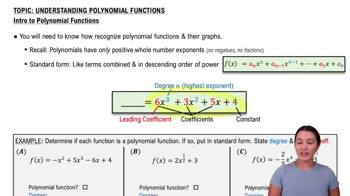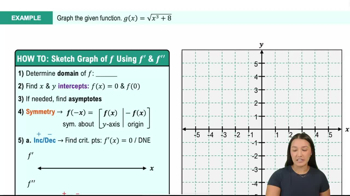Table of contents
- 0. Functions7h 52m
- Introduction to Functions16m
- Piecewise Functions10m
- Properties of Functions9m
- Common Functions1h 8m
- Transformations5m
- Combining Functions27m
- Exponent rules32m
- Exponential Functions28m
- Logarithmic Functions24m
- Properties of Logarithms34m
- Exponential & Logarithmic Equations35m
- Introduction to Trigonometric Functions38m
- Graphs of Trigonometric Functions44m
- Trigonometric Identities47m
- Inverse Trigonometric Functions48m
- 1. Limits and Continuity2h 2m
- 2. Intro to Derivatives1h 33m
- 3. Techniques of Differentiation3h 18m
- 4. Applications of Derivatives2h 38m
- 5. Graphical Applications of Derivatives6h 2m
- 6. Derivatives of Inverse, Exponential, & Logarithmic Functions2h 37m
- 7. Antiderivatives & Indefinite Integrals1h 26m
- 8. Definite Integrals4h 44m
- 9. Graphical Applications of Integrals2h 27m
- 10. Physics Applications of Integrals 2h 22m
5. Graphical Applications of Derivatives
Curve Sketching
Problem 40
Textbook Question
Use the guidelines of this section to make a complete graph of f.
f(x) = 2 - 2x2/3 + x4/3
 Verified step by step guidance
Verified step by step guidance1
Identify the domain of the function f(x) = 2 - 2x^{2/3} + x^{4/3}. Since the function involves fractional exponents, check for any restrictions. In this case, the domain is all real numbers because the exponents are positive and the base x can be any real number.
Find the first derivative f'(x) to determine the critical points and analyze the increasing or decreasing behavior of the function. Use the power rule for derivatives: f'(x) = -\frac{4}{3}x^{-1/3} + \frac{4}{3}x^{1/3}.
Set the first derivative f'(x) equal to zero to find critical points: -\frac{4}{3}x^{-1/3} + \frac{4}{3}x^{1/3} = 0. Solve this equation to find the values of x where the slope of the tangent is zero.
Find the second derivative f''(x) to determine the concavity and points of inflection. Differentiate f'(x) to get f''(x) = \frac{4}{9}x^{-4/3} - \frac{4}{9}x^{-2/3}.
Analyze the behavior of f(x) as x approaches positive and negative infinity to understand the end behavior of the graph. Also, use the second derivative test to confirm the nature of the critical points found in step 3, and identify any points of inflection from the second derivative.
 Verified video answer for a similar problem:
Verified video answer for a similar problem:This video solution was recommended by our tutors as helpful for the problem above
Video duration:
11mPlay a video:
Was this helpful?
Key Concepts
Here are the essential concepts you must grasp in order to answer the question correctly.
Graphing Functions
Graphing functions involves plotting points on a coordinate plane to visualize the relationship between the input (x) and output (f(x)). Understanding how to identify key features such as intercepts, symmetry, and asymptotes is essential for creating an accurate representation of the function.
Recommended video:

Graph of Sine and Cosine Function
Polynomial Functions
The function f(x) = 2 - 2x^(2/3) + x^(4/3) is a polynomial function, which is a sum of terms consisting of variables raised to non-negative integer powers. Recognizing the degree and leading coefficient of the polynomial helps in determining the end behavior and shape of the graph.
Recommended video:

Introduction to Polynomial Functions
Critical Points and Derivatives
Finding critical points involves calculating the derivative of the function and setting it to zero to identify where the function's slope changes. Analyzing these points helps in determining local maxima, minima, and points of inflection, which are crucial for sketching the complete graph accurately.
Recommended video:

Critical Points

 11:41m
11:41mWatch next
Master Summary of Curve Sketching with a bite sized video explanation from Callie
Start learning




